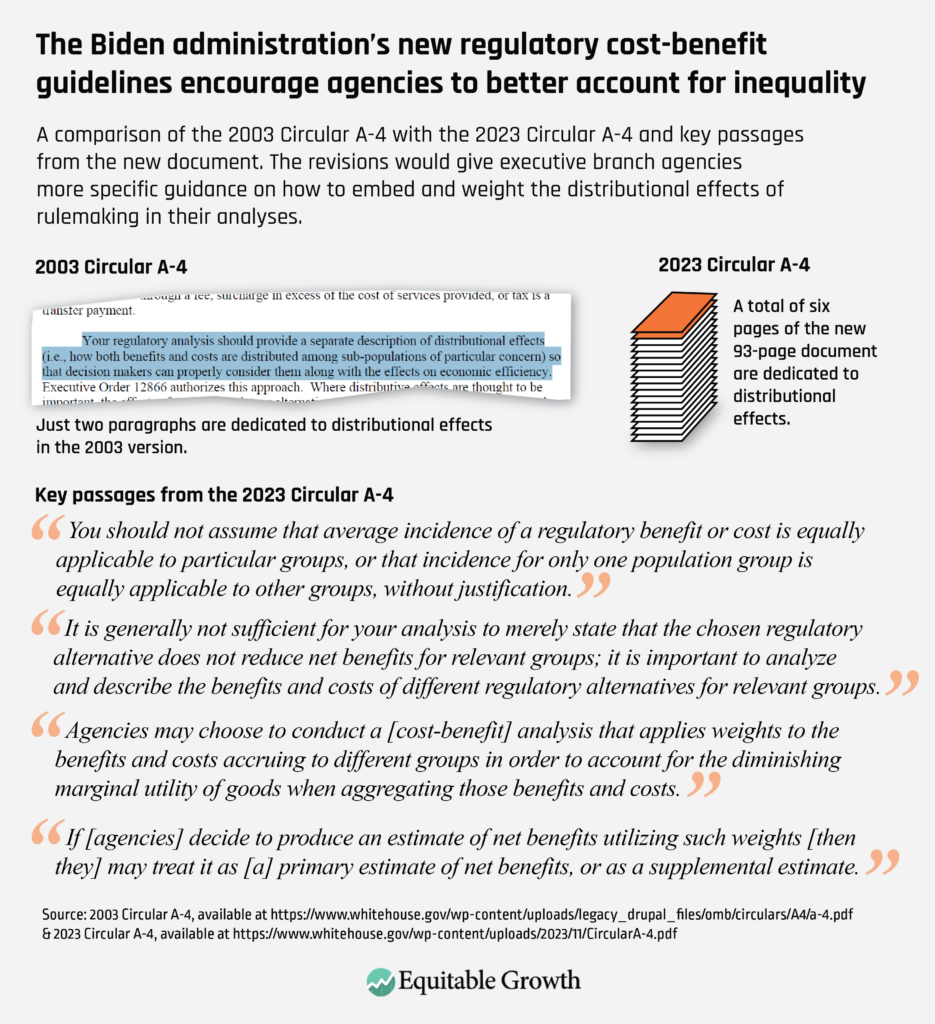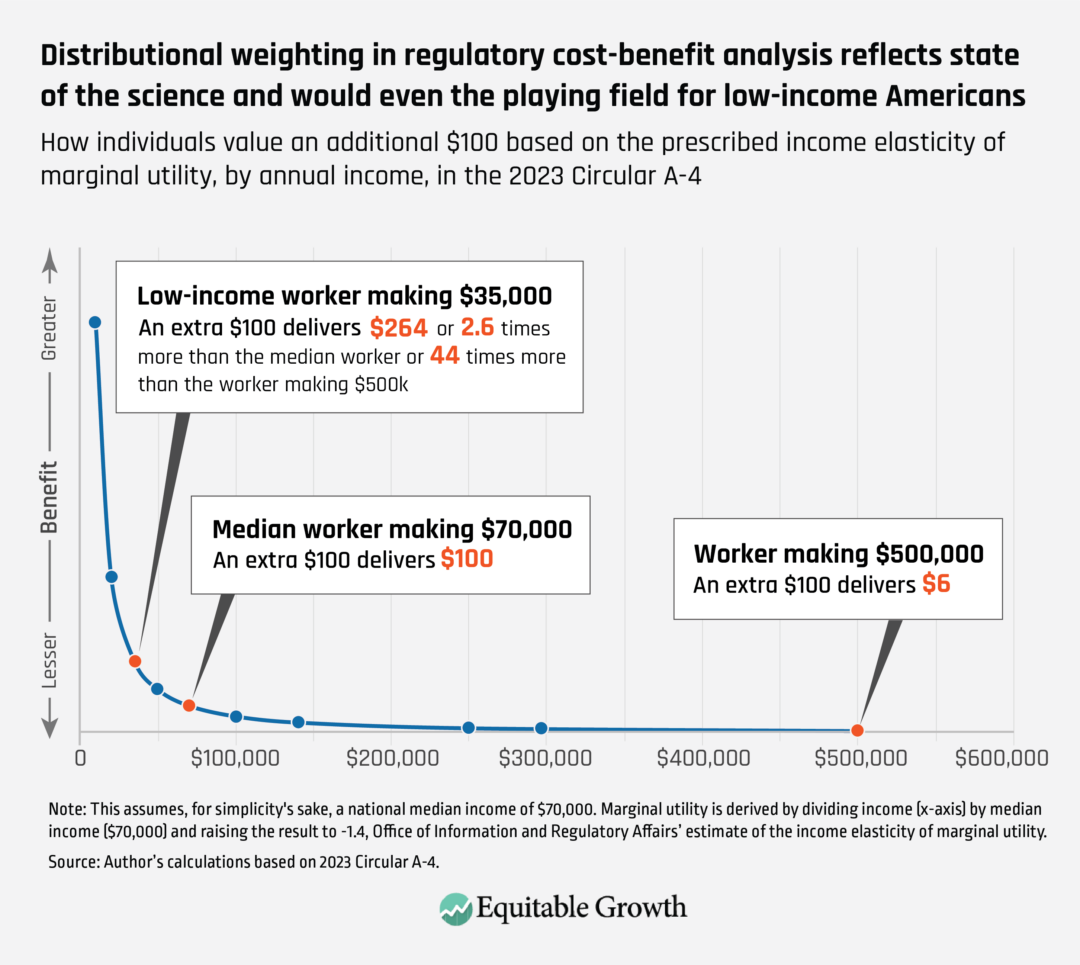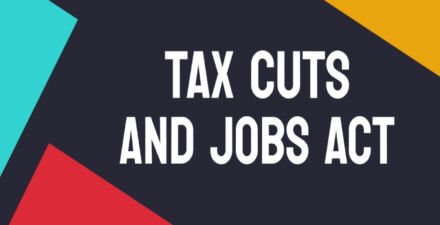New Circular A-4 offers opportunities for researchers interested in disaggregating the costs and benefits of U.S. regulations

This column is adapted from remarks I made at the Allied Social Sciences Associations 2024 annual meeting, held earlier this year in San Antonio, Texas, as part of a panel on “The Missing Piece: How Are Regulatory Costs Distributed?”.
The Circular A-4 is a government guidance document focused on the methodologies federal agencies use when conducting benefit-cost analysis of proposed regulations. Federal agencies are tasked with determining the most efficient policy approach and ensuring cost-effective implementation, running benefit-cost analyses as needed based on the guidance in the Circular A-4.
Many of the regulations at issue can seem fairly arcane—updating energy efficiency standards for dishwashers, ceiling fans, or other consumer products, for example—and they can be small in scope from an economic efficiency or macroeconomic perspective, often seeming to impact firm costs, prices, and wages only marginally. Yet these are largely misconceptions.
Regulations are an incredibly important way in which economic policy is made in the United States, posing complicated policy-design questions with tens of billions of dollars at stake. In fiscal years 2020–2022, the federal government promulgated 266 regulations that were reviewed by the U.S. Office of Management and Budget to ensure compliance with Circular A-4 and general administration priorities. These regulations included rules on:
- Passenger car and light truck corporate average fuel economy standards, delivering total benefits and costs, including those accruing to firms, workers, and the government, of $7.2 billion and $6.9 billion, respectively
- Enactment of new health information technology guidelines, delivering $3.7 billion in benefits and $1 billion in costs
- Implementation of the Coronavirus State and Local Fiscal Recovery Fund program, transferring $234.9 billion to state, local, and tribal governments
In addition to their efficiency and macroeconomic relevance, U.S. regulations also can have major distributional implications, determining “winners” and “losers” across income, wealth, geography, race, and gender, to name a few key socioeconomic and demographic groups. Take, for example, the 2023 rule increasing the minimum wage for federal contractors from $15 per hour to $17.20 per hour. This regulation is expected to lead to higher wages totaling $1.96 billion paid to low-income workers in the United States by the government and other employers.
Historically, these two considerations—efficiency and equity—have been analyzed separately, or worse, pitted against one another, with an assumption baked into classical economic theory that there is an inevitable trade-off between the two. The Washington Center for Equitable Growth was founded in part to question this assumption and, 10 years later, the empirical evidence identifies the many ways in which equity and economic growth are indeed complementary.
In November 2023, the Biden administration released an updated Circular A-4, which relies on extensive research from Equitable Growth-funded and other academics. This new version marks a an important and overdue update: Federal agencies no longer can ignore the distributional considerations of their proposed regulations. Instead, the new conventional wisdom is that equity and efficiency go hand-in-hand and must be analyzed concurrently, as exemplified in the beefed-up sections on distributional analysis in the new Circular A-4. (See Figure 1.)
Figure 1

Equitable Growth is committed to seeing the Circular A-4 successfully implemented and is well-positioned to aid both academics and government officials alike in this quest. We offer grants to academics studying these and similar issues, help researchers navigate government and policy debates, and connect policymakers to academic work that can build the evidence base and make the case for change. Our strong relationships with both government officials and academic researchers mean that we are uniquely able to identify the policy issues and research questions most in need of investigation.
Below, I discuss how the latest revisions to the Circular A-4 might change researchers’ approach to their work and offer opportunities to directly impact policy and set new methodological norms.
Opportunities to directly impact policy
Even before the new Circular A-4 was finalized in November 2023, it was clear that federal agencies were taking distributional analysis more seriously. Genuine efforts to trace the costs of new regulations abounded—for example, the noncompete rule at the Federal Trade Commission, which, as an independent agency, is not actually required to follow the Circular A-4 guidance, and the dishwasher and ceiling fan rules referenced above.
The revised Circular A-4, which encourages but does not require a weighted distributional analysis of all major economic rules, will only increase the number of agencies incorporating this information into their regulatory impact statements. The demand for research—and, specifically, for distributional research on who bears the costs and benefits from regulation—is genuine and growing. But it’s up to researchers to generate the supply needed to meet that demand, and a first step might be better understanding what data the government actually needs.
Indeed, finding the necessary data and analysis in the academic literature is a challenge. The abovementioned FTC noncompete rule, for example, relied on just two academic papers that were on point. And though the U.S. Department of Energy attempted to determine how the dishwasher and ceiling fan rules would affect low-income and senior-only households—two key vulnerable consumer groups—the analysis employed was fairly crude, given a dearth of in-depth studies of these admittedly niche markets.
As a recently issued White House Office of Science and Technology Policy report points out, the Federal Trade Commission and the Department of Energy are not the only federal agencies that need additional research to more holistically analyze the impact of federal regulations. In fact, the report identifies several regulatory policy areas that require more research, including the administrative burdens placed on beneficiaries of public benefit programs, the distribution of transportation costs and benefits, and the impact of improved contract market transparency on poultry growers, to name just a few.
Additionally, every federal agency publishes a regulatory agenda twice a year that lays out the actions the agency expects to pursue over the coming years. These can help researchers better understand the areas where agencies are still building a research base, thus offering a moment of maximum leverage to assist agencies in framing the problems they want to address, as well as possible solutions. Likewise, thanks to a law that was enacted in 2019, agencies are also now required to produce a “learning agenda” every 5 years, which summarizes research questions that agencies flag as important to their ongoing work.
For instance, one regulation on the U.S. Department of Labor’s most recent regulatory agenda—which has been the subject of Equitable Growth-funded research—is the Occupational Safety and Health Administration’s national heat standard. While many states have experimented with their own heat standards, providing potential natural experiments to investigate these questions, the OSHA standard would benefit from a more granular understanding of whether and how employers pass on the costs of providing shade, breaks, or air conditioning to workers. Indeed, the agency dedicated a specific section of its advance notice of proposed rulemaking to data sources that could help reveal whether there are inequalities in exposure to hazardous heat in working conditions and resulting health and safety impacts.
Researchers also can weigh in during a proposed rule’s comment period, which opens after the draft proposal is officially published in the Federal Register. But the impact of research at this stage is more on the details and rationale of a rule, helping agencies determine and defend specific policy design choices, rather than building the research base or guiding agencies as they define the issues they want to address.
It is also important to remember that government officials facing pressing policy questions often have to take the academic literature where it stands and make decisions with the information available to them at the time. This means findings that are not yet formally published, such as those found in working papers or online appendixes, are very valuable. Additionally, researchers can help policymakers by publishing:
- Point estimates of market elasticities, even with wide confidence intervals, so that regulators can estimate the effect of price changes on supply and demand
- Marginal impacts, since regulators are usually interested in the effects of small policy changes rather than the creation of whole new programs
- Distributional information in various forms so that agencies can use the data that best suits their needs (for instance, data by income decile rather than just above and below the federal poverty line)
A lack of timely evidence and data can tilt the process in favor of large, well-resourced organizations—typically private-sector businesses and trade associations most directly affected by the regulations. The bigger the research gaps facing policymakers, the more likely business interests will fill those gaps with their own, often biased analysis. Policymakers understand that preliminary findings are better than nothing—and will eventually be refined over time.
Take, for example, the history of tax incidence research. Policymakers are understandably very interested in knowing who ultimately bears the cost of tax increases and, conversely, who benefits from tax cuts. Over the past several decades, the academic literature on this question has matured considerably, from abstract theory around the mobility of labor and capital to more granular, empirical work that actually traces which workers and firms are affected over both the short term and long term. All the while, government analysts at the U.S. Congress’s Joint Committee on Taxation, the Congressional Budget Office, and the U.S. Treasury Department have followed the academic progress and updated the assumptions that go into their “scores” of tax proposals, a version of distributional benefit-cost analysis, accordingly.
Other disciplines should be open to a similar evolutionary approach to building precision in distributional analysis.
Opportunity to set new methodological norms
While the new Circular A-4 provides more direction to agencies on how to conduct distributional analysis, there are still a number of unanswered methodological questions on just how it will work in practice—for example, on which “subgroups of interest” agencies should focus. The White House Office of Science and Technology report explicitly concedes that the federal government still needs to reach alignment on this point—and the answer will likely look different across different federal agencies and programs.
This provides an opportunity for academic researchers, especially those who have already been grappling with these questions at their universities. Academic initiatives that develop methodological norms built up at universities on, say, how to disaggregate Gross Domestic Product can be adopted by government statisticians, who often see them as proofs of concept to provide the necessary nudge toward action.
Other areas for methodological innovation that could help set new, influential government norms include:
- The threshold of estimated differentiated impact at which a distributional analysis should be triggered and how to more rigorously choose the relevant subgroups for inclusion. For instance, should rulemakings on the Special Supplemental Nutrition Program for Women, Infants, and Children take into account the impact the program has on Black mothers in particular, given the unique challenges they face?
- How to better and more systematically draw from qualitative accounts, such as using surveys, ethnographic research, interview research, and comments, to characterize hard-to-quantify or hard-to-monetize benefits, including those related to equity, dignity, and fairness. Take, for example, the recent rule from the U.S. Department of Transportation on airplane lavatories, which struggled to quantify the benefits of making plane bathrooms wheelchair accessible.
- How to present distributional information in regulatory impact statements so as to make the greatest impression on busy policymakers. Experiments comparing various approaches, and the resulting ability of readers to recall and act on the information, could be helpful.
- How distributional weighting—a novel, and optional, approach to quantifying the value of costs and benefits to individuals up and down the income spectrum (See Figure 2)—can interact with the already somewhat income-weighted “value of a statistical life” calculation used across government.
Figure 2

Conclusion
The new Circular A-4 offers opportunities for researchers to get involved in regulatory design and methodology and for policymakers to work with academics to get the evidence they need to assess and back up their proposals. Given these opportunities for policy impact, it would be a shame if academics find themselves, and their research, sitting on the sidelines. Regulations are critical for making economic policies and have major impact on both economic efficiency and equity. If we want regulations to be based on rigorous evidence, then academics have to play a larger role in producing relevant research than ever before.
I would like to thank Lisa Robinson for moderating the ASSA panel on which this column is based and for inviting me to participate, as well as the Society for Benefit-Cost Analysis for hosting. I would also like to thank my fellow panelists Ann Wolverton, Donald Kenkel, and Lori Bennear for their thoughtful contributions to the discussion.




